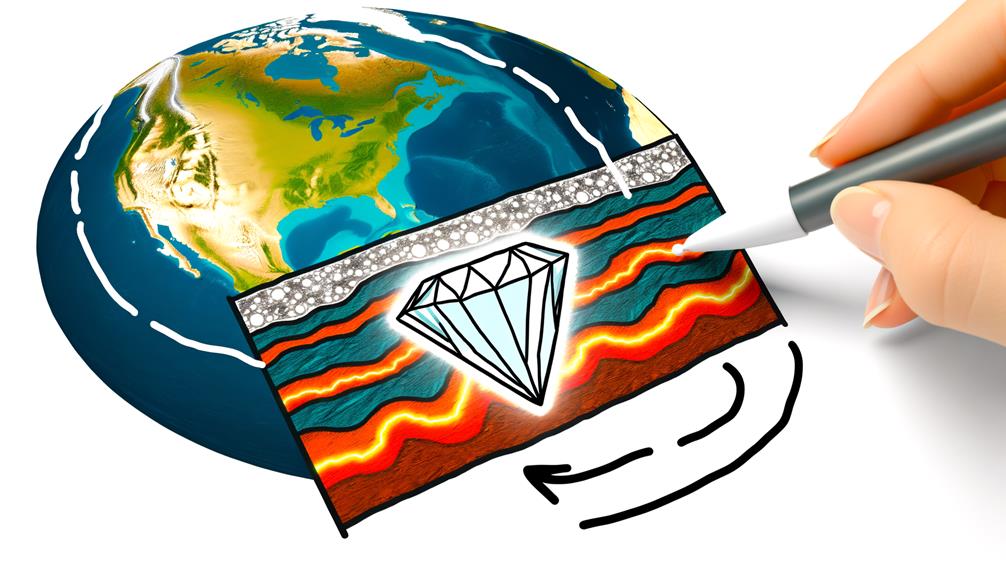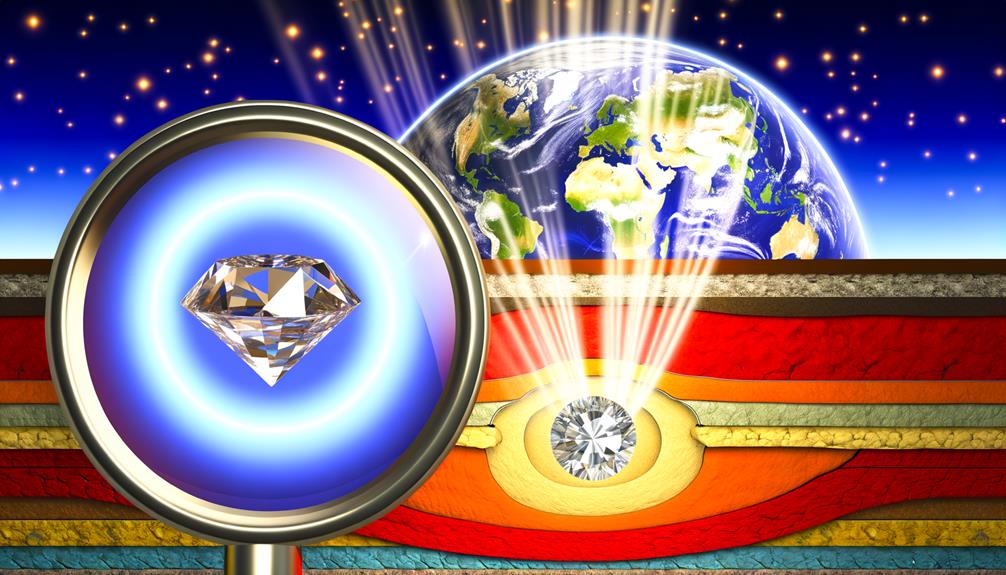Article Contents
- 1 Key Takeaways About Superdeep Diamonds
- 2 Unearthing Superdeep Diamonds
- 3 Deciphering Geological Processes
- 4 Analyzing Diamond Inclusions
- 5 Tracing Gondwanas Footsteps
- 6 Implications for Continental Growth
- 7 Frequently Asked Questions
- 7.1 How Do the Properties of Superdeep Diamonds Compare to Those of Diamonds Formed at Shallower Depths?
- 7.2 Can the Study of Superdeep Diamonds Offer Insights Into the Potential for Undiscovered Mineral Deposits Within Ancient Continental Roots?
- 7.3 How Does the Diamond Formation Process Affect the Stability and Composition of the Continental Lithosphere Over Geological Time Scales?
- 7.4 What Technological Advancements Have Enabled the Precise Dating and Analysis of Inclusions Within Superdeep Diamonds?
- 7.5 Are There Regions on Earth Undergoing Similar Geological Processes That Led to the Formation of Diamonds Beneath Gondwana?
- 8 Superdeep Diamonds Wrapped Up
- 9 Further reading About Superdeep Diamonds
Diamonds form under Earth’s harsh conditions. They give unique insights into how supercontinents have evolved. By studying these gems, scientists can learn about the geological movements and mantle dynamics that shaped our planet over billions of years.
Diamond inclusions allow researchers to understand the complex history of tectonic plate movements. They show how ancient supercontinents like Gondwana formed and broke apart. These natural time capsules show us how continents grow and merge, giving us a clearer view of Earth’s interior and its ongoing evolution.
For those interested in Earth’s geological history, diamonds unlock the mysteries of supercontinent dynamics. These precious gemstones provide insights into the immense pressures and temperatures deep within the Earth’s mantle, where they form over billions of years. By studying their inclusions, scientists can trace the cycling of materials through tectonic processes and better understand the assembly and breakup of ancient landmasses. The kohinoor diamond history, for instance, not only reflects its geological origins but also offers a fascinating glimpse into the cultural and political landscapes shaped by Earth’s treasures. Diamonds are not the only gemstones with valuable geological insights. Morganite, a pink variety of beryl, also provides a window into Earth’s ancient processes. Its coloration is due to the presence of manganese, a trace element that can reveal the conditions of formation and the environment within the Earth’s crust. Understanding the benefits of morganite and other gemstones can offer a more holistic view of Earth’s geological history and the intricate processes that have shaped our planet over billions of years.
Key Takeaways About Superdeep Diamonds
- Superdeep diamonds are like time capsules from deep within the Earth, showing us how giant landmasses formed and split apart.
- They capture extreme conditions deep inside Earth, thanks to tiny pieces trapped inside them.
- By studying these special diamonds, we learn how Earth’s plates have shifted for billions of years.
- Diamonds hint at how old supercontinents, like Gondwana, came together and changed.
- Looking into diamonds tells us more about how continents grow and what happens deep under our feet.
Unearthing Superdeep Diamonds
The study of superdeep diamonds reveals much about how supercontinents form and change. These diamonds, deep in Earth’s mantle, are like time capsules. They hold secrets about deep Earth and its tectonics.
By looking at how diamonds form, researchers are learning about supercontinents. This helps us understand the Earth’s geological movements. These diamonds form under extreme conditions and eventually move to the surface. This journey shows us how our planet changes shape.
Deciphering Geological Processes
Building on what we know about superdeep diamonds, we must investigate their creation’s geological processes. This includes how these processes affect the history of supercontinents. To do this, we look at geochemical data and tectonic processes, which are key to unlocking the secrets of these processes.
| Aspect | Significance |
| Geochemical Data | Gives hints about how diamonds form and what’s deep inside the Earth. |
| Tectonic Processes | Explains how Earth’s plates move and interact. |
Analyzing Diamond Inclusions
Exploring diamond inclusions gives us unique insights into the deep processes shaping the evolution of supercontinents. These tiny inclusions within diamonds allow scientists to understand the extreme conditions diamonds form under. They also reveal the complex movements of Earth’s plates over billions of years.
- Understanding Diamond Formation: The study of inclusions helps us learn about the extreme conditions needed for diamond formation. This tells us about the Earth’s deep interior.
- Insights into Subterranean Processes: Examining inclusions can reveal how Earth’s tectonic plates move and interact, which is key to understanding the cycles of supercontinents.
- Revealing Earth’s History: Every inclusion has a story of the Earth’s past. They give valuable information on how supercontinents, like Gondwana, have evolved.
Studying inclusions makes us appreciate our planet’s complex and dynamic geological processes more deeply.

Tracing Gondwanas Footsteps
Gondwana was a supercontinent that existed during the Paleozoic and Mesozoic eras, around 600 to 180 million years ago. The merging of several landmasses, including Africa, South America, Antarctica, Australia, the Indian subcontinent, and the Arabian Peninsula formed it.
Gondwana played a significant role in Earth’s geological history, influencing the distribution of flora and fauna and shaping the continents as we know them today. The breakup of Gondwana eventually led to the formation of the Southern Hemisphere continents.
Exploring Gondwana’s journey reveals key insights into how supercontinents form and break apart over time. This story, tied to tectonic movements and deep subduction, tells us much about the mantle’s changes under ancient supercontinents.
As continents moved and joined, the tectonic plates beneath them performed a complex dance of creation and destruction. This not only shaped our planet’s surface but also played a major role in the evolution of the mantle —the layer just below the Earth’s crust.
Implications for Continental Growth
Understanding Gondwana’s geological past sheds light on how continents grow, focusing on the role of diamonds. This knowledge deepens our understanding of Earth’s history and opens new paths for studying how continents form and expand.
- New Growth Mechanisms: Diamonds show us how continents can add material from deep below, pointing to new ways continents might expand.
- Understanding Continental Assembly: Looking at what’s trapped inside diamonds hints at the order in which supercontinents came together. This helps us better understand how continents drift and join.
- Encouraging Curiosity: Studying diamonds and their secrets encourages a free and curious approach to exploring Earth’s deep mysteries. This promotes a culture of curiosity and freedom in scientific exploration.
Together, these insights deepen our understanding of Earth’s dynamic geological history and its constant changes.
Frequently Asked Questions
How Do the Properties of Superdeep Diamonds Compare to Those of Diamonds Formed at Shallower Depths?
Superdeep diamonds come from 300-700 km below the earth’s surface. They show unique colours and need special cutting methods. This difference points to their deep-earth birth and the intense processes that affect our planet’s history. Furthermore, superdeep diamonds are incredibly rare and valuable due to their unique origins and characteristics. The intense pressure and heat they are subjected to deep within the earth result in their exceptional clarity and brilliance. To bring out the full beauty of these remarkable gems, skilled gemologists utilize skysparkling technology to ensure the perfect cut and polish, allowing these diamonds to truly shine like no other.
Can the Study of Superdeep Diamonds Offer Insights Into the Potential for Undiscovered Mineral Deposits Within Ancient Continental Roots?
Research into superdeep diamonds sheds light on the movements of the Earth’s mantle and the diversity of crystals. This work may reveal hidden mineral deposits in the ancient roots of continents. It gives us a fresh view of how the Earth works and the chances of finding new resources.
How Does the Diamond Formation Process Affect the Stability and Composition of the Continental Lithosphere Over Geological Time Scales?
The formation of diamonds, driven by the movements of tectonic plates and the churning of the mantle, deeply affects the continental lithosphere’s stability and makeup. This process plays a key role in the ongoing change and development of Earth’s geological features through the ages.
What Technological Advancements Have Enabled the Precise Dating and Analysis of Inclusions Within Superdeep Diamonds?
Advancements in technology have refined the methods used to date and analyse the chemistry of inclusions in superdeep diamonds. These methods offer clear insights into the processes happening deep within the earth. This has significantly improved our grasp of geological events.
Are There Regions on Earth Undergoing Similar Geological Processes That Led to the Formation of Diamonds Beneath Gondwana?
Today, areas with plate tectonics and volcanic activity similar to Gondwana’s time of diamond creation are under close study. Experts use cutting-edge methods to explore these processes; their goal is to learn more about how Earth changes.
Superdeep Diamonds Wrapped Up
The study of diamonds from deep within the Earth has changed how we understand the formation of supercontinents, especially Gondwana. Researchers have found new ways continents grow by studying tiny pieces of silicate and sulphide trapped in these diamonds.
These findings show how deep Earth processes shape our planet. This research proves that diamonds are key to exploring Earth’s interior. It also sheds light on how continents come together and break apart, marking a big step forward in the study of geology.
Further reading About Superdeep Diamonds
- Superdeep diamonds illustrate supercontinent growth
- Superdeep diamonds reveal the Earth’s ancient secrets
- Eternal echoes of superdeep diamonds can resonate in modern jewellery
- Researchers use superdeep diamonds to shed light on the Earth’s inner workings
- Superdeep diamonds deepen our understanding of plate tectonics



